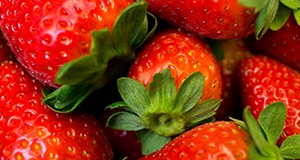 Like the web-based SAS, the SAS: Strawberry Advisory System mobile app monitors real-time and forecast weather conditions that increase the risk for Botrytis (gray mold) and anthracnose fruit rots, providing risk level information for each disease. The app provides easy access to the information growers need to make spraying decisions in the field, saving them time, helping improve disease control, and avoiding unnecessary fungicide applications. This 3-page fact sheet provides an overview of the SAS mobile app. Written by Clyde W. Fraisse, Natalia Peres, and José Henrique Andreis, and published by the UF Department of Agricultural and Biological Engineering, August 2015.
Like the web-based SAS, the SAS: Strawberry Advisory System mobile app monitors real-time and forecast weather conditions that increase the risk for Botrytis (gray mold) and anthracnose fruit rots, providing risk level information for each disease. The app provides easy access to the information growers need to make spraying decisions in the field, saving them time, helping improve disease control, and avoiding unnecessary fungicide applications. This 3-page fact sheet provides an overview of the SAS mobile app. Written by Clyde W. Fraisse, Natalia Peres, and José Henrique Andreis, and published by the UF Department of Agricultural and Biological Engineering, August 2015.
http://edis.ifas.ufl.edu/ae516
Tag: Agricultural and Biological Engineering Department
Estimated Water Savings Potential of Florida-Friendly Landscaping™ Activities

To help homeowners predict the impact of implementing some of the water conservation measures listed on Florida-Friendly Landscaping™ checklist, this 5-page fact sheet offers a table of estimated water savings. Homeowners can select activities which are the best fit for their landscape and can also see which have the most conservation potential. The water savings is compared to a baseline case of typical irrigation behavior. This 5-page fact sheet was written by Mackenzie Boyer and Michael Dukes, and published by the UF Department of Agricultural and Biological Engineering, August 2015. (Photo credit: Michael Gutierrez, UF/IFAS)
http://edis.ifas.ufl.edu/ae515
Field Observations During the Eleventh Microwave Water and Energy Balance Experiment (MicroWEX-11) from April 25 through December 6, 2012
 This new report from UF/IFAS researchers provides another set of observation data that can be used to develop better models for accurate prediction of weather and near-term climate. It describes the observations conducted during the MicroWEX-11, a season-long experiment incorporating active and passive microwave observations for bare soil, elephant grass, and sweet corn using a variety of sensors to understand land–atmosphere interactions and their effect on observed microwave signatures. These observations match that of satellite-based passive microwave radiometers and NASA’s recently launched Soil Moisture Active Passive (SMAP) mission. This 96-page report was written by Tara Bongiovanni, Pang-Wei Liu, Karthik Nagarajan, Daniel Preston, Patrick Rush, Tim H.M. van Emmerik, Robert Terwilleger, Alejandro Monsivais-Huertero, Jasmeet Judge, Susan Steele-Dunne, Roger De Roo, Ruzbeh Akbar, Ella Baar, Max Wallace, and Anthony England and published by the UF Department of Agricultural and Biological Engineering, July 2015.
This new report from UF/IFAS researchers provides another set of observation data that can be used to develop better models for accurate prediction of weather and near-term climate. It describes the observations conducted during the MicroWEX-11, a season-long experiment incorporating active and passive microwave observations for bare soil, elephant grass, and sweet corn using a variety of sensors to understand land–atmosphere interactions and their effect on observed microwave signatures. These observations match that of satellite-based passive microwave radiometers and NASA’s recently launched Soil Moisture Active Passive (SMAP) mission. This 96-page report was written by Tara Bongiovanni, Pang-Wei Liu, Karthik Nagarajan, Daniel Preston, Patrick Rush, Tim H.M. van Emmerik, Robert Terwilleger, Alejandro Monsivais-Huertero, Jasmeet Judge, Susan Steele-Dunne, Roger De Roo, Ruzbeh Akbar, Ella Baar, Max Wallace, and Anthony England and published by the UF Department of Agricultural and Biological Engineering, July 2015.
http://edis.ifas.ufl.edu/ae514
SmartIrrigation Avocado App: A Step-by-Step Guide
 UF’s SmartIrrigation Avocado for iOS and Android platforms provides a simple ET-based method to schedule irrigation and is expected to provide 20% to 50% water savings based on findings with other schedule tools. This 6-page fact sheet provides configuration instructions and main menu features. Written by D. Mbabazi, K. W. Migliaccio, J. H. Crane, J. H. Debastiani Andreis, C. Fraisse, L. Zotarelli, and K. T. Morgan, and published by the UF Department of Agricultural and Biological Engineering, May 2015.
UF’s SmartIrrigation Avocado for iOS and Android platforms provides a simple ET-based method to schedule irrigation and is expected to provide 20% to 50% water savings based on findings with other schedule tools. This 6-page fact sheet provides configuration instructions and main menu features. Written by D. Mbabazi, K. W. Migliaccio, J. H. Crane, J. H. Debastiani Andreis, C. Fraisse, L. Zotarelli, and K. T. Morgan, and published by the UF Department of Agricultural and Biological Engineering, May 2015.
http://edis.ifas.ufl.edu/ae513
The Role and Impact of Technology on Supply-Chain Management in the Food Industry
 In competitive markets, innovations such as electronic devices, information technology, and green and sustainable technologies can provide a competitive advantage in managing the supply chain, and determine which operations succeed and which fail. The information in this article is intended to provide insight regarding the potential benefits and limitations of these technologies so that firms in the food industry can make more informed decisions on which technologies should be incorporated into their own systems and to what degree. This 5-page fact sheet was written by Jonathan A. Watson, Allen F. Wysocki, and Ray A. Bucklin, and published by the UF Department of Agricultural and Biological Engineering, April 2015. (UF/IFAS photo: Thomas Wright)
In competitive markets, innovations such as electronic devices, information technology, and green and sustainable technologies can provide a competitive advantage in managing the supply chain, and determine which operations succeed and which fail. The information in this article is intended to provide insight regarding the potential benefits and limitations of these technologies so that firms in the food industry can make more informed decisions on which technologies should be incorporated into their own systems and to what degree. This 5-page fact sheet was written by Jonathan A. Watson, Allen F. Wysocki, and Ray A. Bucklin, and published by the UF Department of Agricultural and Biological Engineering, April 2015. (UF/IFAS photo: Thomas Wright)
http://edis.ifas.ufl.edu/ae511
Your Farm Weather Station: Installation and Maintenance Guidelines
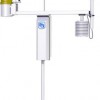 Weather is a prominent factor in the success or failure of agricultural enterprises, and the technology is improved and less expensive, so many farmers are installing farm-based weather stations for tracking weather conditions, scheduling irrigation, make decisions related to cold protection, and accomplish other tasks. But management decisions must be based on high-quality observations. Sensors must meet accepted minimum accuracy standards, the station must be sited properly and well-maintained.
Weather is a prominent factor in the success or failure of agricultural enterprises, and the technology is improved and less expensive, so many farmers are installing farm-based weather stations for tracking weather conditions, scheduling irrigation, make decisions related to cold protection, and accomplish other tasks. But management decisions must be based on high-quality observations. Sensors must meet accepted minimum accuracy standards, the station must be sited properly and well-maintained.
This 5-page fact sheet provides farmers with basic guidelines for installing and maintaining a weather station. Written by Clyde W. Fraisse, George W. Braun, William R. Lusher, and Lee R. Staudt, and published by the UF Department of Agricultural and Biological Engineering, April 2015.
http://edis.ifas.ufl.edu/ae502
Water Use for Seepage-Irrigated Watermelon with Plastic Mulch in Florida
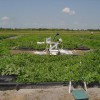 In Florida, watermelon is an important crop that accounts for a significant part of the state’s agricultural water use. Depending on the type of production system and climate, the water use of this crop can vary. In Florida, watermelon is predominantly grown on raised plastic-mulched beds. To develop improved water management and allocation plans, accurate water use estimates for watermelon are needed. Seepage irrigation under plastic mulch is a common production system used to produce watermelon in south and northeast Florida where the water table is shallow. Plastic mulch alters the rainfall entry and soil temperature of the raised beds and can significantly affect evapotranspiration. As there is no information on seepage-irrigated watermelon grown on plastic mulch for subtropical Florida, this 4-page fact sheet summarizes the results from a crop water use study for the seepage-irrigated watermelon in south Florida. Written by Sanjay Shukla and Niroj K. Shrestha, and published by the UF Department of Agricultural and Biological Engineering, August 2014.
In Florida, watermelon is an important crop that accounts for a significant part of the state’s agricultural water use. Depending on the type of production system and climate, the water use of this crop can vary. In Florida, watermelon is predominantly grown on raised plastic-mulched beds. To develop improved water management and allocation plans, accurate water use estimates for watermelon are needed. Seepage irrigation under plastic mulch is a common production system used to produce watermelon in south and northeast Florida where the water table is shallow. Plastic mulch alters the rainfall entry and soil temperature of the raised beds and can significantly affect evapotranspiration. As there is no information on seepage-irrigated watermelon grown on plastic mulch for subtropical Florida, this 4-page fact sheet summarizes the results from a crop water use study for the seepage-irrigated watermelon in south Florida. Written by Sanjay Shukla and Niroj K. Shrestha, and published by the UF Department of Agricultural and Biological Engineering, August 2014.
http://edis.ifas.ufl.edu/ae510
Water Use for Seepage-Irrigated Pepper with Plastic Mulch in Florida
 Bell pepper (Capsicum annuum) is an important crop for Florida and accounts for a significant fraction of its agricultural water use. Most of it is produced in south Florida, where the water table is shallow. Seepage irrigation is one of the most common systems used in south Florida for growing plastic-mulched vegetable crops, including bell pepper. Compared with an open field production, covering the soil with impermeable plastic reduces soil evaporation and increases transpiration. This 3-page fact sheet summarizes the results from a crop water use study for the seepage-irrigated pepper in south Florida.
Bell pepper (Capsicum annuum) is an important crop for Florida and accounts for a significant fraction of its agricultural water use. Most of it is produced in south Florida, where the water table is shallow. Seepage irrigation is one of the most common systems used in south Florida for growing plastic-mulched vegetable crops, including bell pepper. Compared with an open field production, covering the soil with impermeable plastic reduces soil evaporation and increases transpiration. This 3-page fact sheet summarizes the results from a crop water use study for the seepage-irrigated pepper in south Florida.
Written by Sanjay Shukla, Niroj Shrestha, and Fouad H. Jaber, and published by the UF Department of Agricultural and Biological Engineering, August 2014.
http://edis.ifas.ufl.edu/ae509
Water Use for Drip-Irrigated Watermelon with Plastic Mulch in Florida
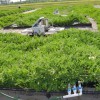 Watermelon is an important crop in Florida and accounts for a significant part of its agricultural water use. Watermelon is grown in open fields and on raised plastic-mulched beds, with the latter being the predominant production system in Florida. Accurate water use estimates for this crop are needed to develop better water allocation and management plans as well as for irrigation management. This publication summarizes the results from a crop water-use study for the drip-irrigated watermelon in south Florida. This 3-page fact sheet was written by Sanjay Shukla, Niroj K. Shrestha, Thomas A. Obreza, and Brian J. Boman, and published by the UF Department of Agricultural and Biological Engineering, August 2014.
Watermelon is an important crop in Florida and accounts for a significant part of its agricultural water use. Watermelon is grown in open fields and on raised plastic-mulched beds, with the latter being the predominant production system in Florida. Accurate water use estimates for this crop are needed to develop better water allocation and management plans as well as for irrigation management. This publication summarizes the results from a crop water-use study for the drip-irrigated watermelon in south Florida. This 3-page fact sheet was written by Sanjay Shukla, Niroj K. Shrestha, Thomas A. Obreza, and Brian J. Boman, and published by the UF Department of Agricultural and Biological Engineering, August 2014.
http://edis.ifas.ufl.edu/ae508
Factors Affecting Phosphorus Leaching and Groundwater Concentrations for the Plasticulture Vegetable-Production System
 Although Best Management Practices (BMPs) have been developed to reduce the loss of nutrients, like P, to the environment, limited information exists on the main factors that control P loss to Florida groundwater. For example, while it is generally accepted that both irrigation and fertilizer P impact groundwater P, growers often ask if controlling one is more advantageous than the other in their efforts to reduce P leaching. There exists no easy tool to link fertilizer P input and other factors to groundwater P concentration. This 5-page fact sheet uses long-term data (six growing seasons) from a farm in Immokalee, Florida, to explain the effects of soil and agronomic factors, along with seasonal rainfall, on groundwater P. From these factors are derived simple equations to predict groundwater P concentrations. Written by Sanjay Shukla, Gregory S. Hendricks, Thomas A. Obreza, and Willie Harris, and published by the UF Department of Agricultural and Biological Engineering, August 2014.
Although Best Management Practices (BMPs) have been developed to reduce the loss of nutrients, like P, to the environment, limited information exists on the main factors that control P loss to Florida groundwater. For example, while it is generally accepted that both irrigation and fertilizer P impact groundwater P, growers often ask if controlling one is more advantageous than the other in their efforts to reduce P leaching. There exists no easy tool to link fertilizer P input and other factors to groundwater P concentration. This 5-page fact sheet uses long-term data (six growing seasons) from a farm in Immokalee, Florida, to explain the effects of soil and agronomic factors, along with seasonal rainfall, on groundwater P. From these factors are derived simple equations to predict groundwater P concentrations. Written by Sanjay Shukla, Gregory S. Hendricks, Thomas A. Obreza, and Willie Harris, and published by the UF Department of Agricultural and Biological Engineering, August 2014.
http://edis.ifas.ufl.edu/ae507
Using Multi-Sensor Soil Moisture Probes to Decide When and How Long to Run Drip Irrigation
 Several methods of irrigation scheduling are used by producers, including the feel method, calendar method, soil water balance method, and soil moisture measurement method. The latter two methods are superior and help avoid too much or too little irrigation, because they consider the water storage within the plant root zone. The soil moisture method commonly involves measuring soil moisture in the root zone and irrigating when the soil moisture falls below 33% or 50% depletion of available water capacity (water in soil that is available to the plant). This 6-page fact sheet was written by Sanjay Shukla and Nathan Holt, and published by the UF Department of Agricultural and Biological Engineering, July 2014.
Several methods of irrigation scheduling are used by producers, including the feel method, calendar method, soil water balance method, and soil moisture measurement method. The latter two methods are superior and help avoid too much or too little irrigation, because they consider the water storage within the plant root zone. The soil moisture method commonly involves measuring soil moisture in the root zone and irrigating when the soil moisture falls below 33% or 50% depletion of available water capacity (water in soil that is available to the plant). This 6-page fact sheet was written by Sanjay Shukla and Nathan Holt, and published by the UF Department of Agricultural and Biological Engineering, July 2014.
http://edis.ifas.ufl.edu/ae505
Interpreting Dye Test Results for Improved Drip Irrigation Management for the Mulched Vegetable-Production Systems in South Florida
 With Florida’s water withdrawals expected to increase by 30% from 2000 to 2030, South Florida vegetable producers are conserving water by converting traditional seepage irrigation systems to drip irrigation, which can have up to 90% efficiency when used effectively. Dye tests can provide important information for implementing a proper drip irrigation management program. This 6-page fact sheet was written by Sanjay Shukla, Nathan Holt, and Gregory Hendricks, and published by the UF Department of Agricultural and Biological Engineering, July 2014.
With Florida’s water withdrawals expected to increase by 30% from 2000 to 2030, South Florida vegetable producers are conserving water by converting traditional seepage irrigation systems to drip irrigation, which can have up to 90% efficiency when used effectively. Dye tests can provide important information for implementing a proper drip irrigation management program. This 6-page fact sheet was written by Sanjay Shukla, Nathan Holt, and Gregory Hendricks, and published by the UF Department of Agricultural and Biological Engineering, July 2014.
http://edis.ifas.ufl.edu/ae506
BMP-Recommended Water and Phosphorus Inputs for Tomato and Watermelon Can Reduce Environmental Losses of Phosphorus and Save Water
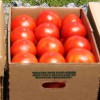 A BMP study was conducted at the research farm of the UF/IFAS Southwest Florida Research and Education Center in Immokalee, FL. The study evaluated two production systems made up of two levels of water and fertilizer inputs for tomato and watermelon production with seepage irrigation. The average water and P fertilizer rates used by growers in south Florida were contrasted with the recommended BMP rates. Applying BMP-recommended water and phosphorus (P) inputs for seepage-irrigated tomato and watermelon in Florida can reduce water use and P leaching to groundwater without adversely impacting fruit yield. However, given the adverse impacts on watermelon yield due to lower than sufficient levels of K, further research is needed to evaluate the fertilizer recommendations for watermelon, especially K2O rates, to ensure economic viability of farms. Our results showed that adoption of BMP-recommended P rates as a BMP did not reduce crop yield and improved water quality. This 4-page fact sheet was written by Sanjay Shukla, Gregory S. Hendricks, Thomas A. Obreza, and Willie G. Harris, and published by the UF Department of Agricultural and Biological Engineering, June 2014.
A BMP study was conducted at the research farm of the UF/IFAS Southwest Florida Research and Education Center in Immokalee, FL. The study evaluated two production systems made up of two levels of water and fertilizer inputs for tomato and watermelon production with seepage irrigation. The average water and P fertilizer rates used by growers in south Florida were contrasted with the recommended BMP rates. Applying BMP-recommended water and phosphorus (P) inputs for seepage-irrigated tomato and watermelon in Florida can reduce water use and P leaching to groundwater without adversely impacting fruit yield. However, given the adverse impacts on watermelon yield due to lower than sufficient levels of K, further research is needed to evaluate the fertilizer recommendations for watermelon, especially K2O rates, to ensure economic viability of farms. Our results showed that adoption of BMP-recommended P rates as a BMP did not reduce crop yield and improved water quality. This 4-page fact sheet was written by Sanjay Shukla, Gregory S. Hendricks, Thomas A. Obreza, and Willie G. Harris, and published by the UF Department of Agricultural and Biological Engineering, June 2014.
http://edis.ifas.ufl.edu/ae504
Water and Nitrogen BMPs for Tomato and Watermelon: Water Quality and Economics
 Results of a two-year, four-crop-cycles experiment indicated that the recommended Best Management Practice (BMP) water and fertilizer nitrogen (N) rates for seepage-irrigated tomato in south Florida can reduce water use and N leaching to groundwater without adversely impacting yield. The same is true for watermelon for average rainfall conditions. This 5-page fact sheet was written by Sanjay Shukla, Gregory S. Hendricks, Fritz M. Roka, and Thomas A. Obreza, and published by the UF Department of Agricultural and Biological Engineering, May 2014.
Results of a two-year, four-crop-cycles experiment indicated that the recommended Best Management Practice (BMP) water and fertilizer nitrogen (N) rates for seepage-irrigated tomato in south Florida can reduce water use and N leaching to groundwater without adversely impacting yield. The same is true for watermelon for average rainfall conditions. This 5-page fact sheet was written by Sanjay Shukla, Gregory S. Hendricks, Fritz M. Roka, and Thomas A. Obreza, and published by the UF Department of Agricultural and Biological Engineering, May 2014.
http://edis.ifas.ufl.edu/ae503
How to Determine Run Time and Irrigation Cycles for Drip Irrigation: Tomato and Pepper Examples
 Even though drip irrigation is more efficient than the other irrigation methods, proper system management is crucial if that increased efficiency is going to result in water savings and a viable crop. One important aspect of drip irrigation management for crop success is irrigation scheduling, which includes determining both how much and when to irrigate. The grower can use several different methods to help develop a suitable irrigation schedule. Proper scheduling needs to be implemented to take full advantage of the increased drip irrigation efficiency. Two examples are presented in this 5-page fact sheet for tomatoes and peppers, which are two important vegetable crops in Florida, to demonstrate the use of reference evapotranspiration and crop coefficients in developing a drip irrigation schedule. Written by Sanjay Shukla, James M. Knowles, and Niroj K. Shrestha, and published by the UF Department of Agricultural and Biological Engineering, April 2014.
Even though drip irrigation is more efficient than the other irrigation methods, proper system management is crucial if that increased efficiency is going to result in water savings and a viable crop. One important aspect of drip irrigation management for crop success is irrigation scheduling, which includes determining both how much and when to irrigate. The grower can use several different methods to help develop a suitable irrigation schedule. Proper scheduling needs to be implemented to take full advantage of the increased drip irrigation efficiency. Two examples are presented in this 5-page fact sheet for tomatoes and peppers, which are two important vegetable crops in Florida, to demonstrate the use of reference evapotranspiration and crop coefficients in developing a drip irrigation schedule. Written by Sanjay Shukla, James M. Knowles, and Niroj K. Shrestha, and published by the UF Department of Agricultural and Biological Engineering, April 2014.
http://edis.ifas.ufl.edu/ae500
Cattle Fencing BMP Can Reduce Phosphorus Loads from Florida Ranches
 BMPs are an important tool in helping the state and individual landowners protect and enhance state’s waters. Given the water quality issues facing Lake Okeechobee and other sensitive water bodies, the importance of BMP implementation has increased since their official establishment as part of the FWRA. In order to ensure that BMPs are reducing nutrient loadings, on-farm research is needed to verify BMP effectiveness. A four-year study was conducted to evaluate the effectiveness of the cow/calf stream fencing BMP. The study concluded that the BMP did reduce the amount of P being discharged from the ranch. This BMP should continue to be included in the cow/calf BMP manual, and, hopefully, its widespread implementation will help the state in meeting its TMDLs. This 3-page fact sheet was written by Sanjay Shukla, Wendy D. Graham, Alan Hodges, and James M. Knowles, and published by the UF Department of Agricultural and Biological Engineering, May 2014.
BMPs are an important tool in helping the state and individual landowners protect and enhance state’s waters. Given the water quality issues facing Lake Okeechobee and other sensitive water bodies, the importance of BMP implementation has increased since their official establishment as part of the FWRA. In order to ensure that BMPs are reducing nutrient loadings, on-farm research is needed to verify BMP effectiveness. A four-year study was conducted to evaluate the effectiveness of the cow/calf stream fencing BMP. The study concluded that the BMP did reduce the amount of P being discharged from the ranch. This BMP should continue to be included in the cow/calf BMP manual, and, hopefully, its widespread implementation will help the state in meeting its TMDLs. This 3-page fact sheet was written by Sanjay Shukla, Wendy D. Graham, Alan Hodges, and James M. Knowles, and published by the UF Department of Agricultural and Biological Engineering, May 2014.
http://edis.ifas.ufl.edu/ae501
Smartirrigation Apps: Urban Turf
 We developed an app called Smartirrigation Turf to provide an easy-to-use mobile tool that delivers information to improve irrigation scheduling for urban turf. Using the app instead of a set time-based schedule for irrigation, homeowners and others can provide irrigation amounts to turf that more closely match water needs. This version of the app is applicable in Florida and Georgia and is available to download in the Apple App Store and Google Play Store. This 5-page fact sheet was written by K. W. Migliaccio, J. H. Debastiani Andreis, C. Fraisse, K. T. Morgan, and G. Vellidis, and published by the UF Department of Agricultural and Biological Engineering, October 2013.
We developed an app called Smartirrigation Turf to provide an easy-to-use mobile tool that delivers information to improve irrigation scheduling for urban turf. Using the app instead of a set time-based schedule for irrigation, homeowners and others can provide irrigation amounts to turf that more closely match water needs. This version of the app is applicable in Florida and Georgia and is available to download in the Apple App Store and Google Play Store. This 5-page fact sheet was written by K. W. Migliaccio, J. H. Debastiani Andreis, C. Fraisse, K. T. Morgan, and G. Vellidis, and published by the UF Department of Agricultural and Biological Engineering, October 2013.
http://edis.ifas.ufl.edu/ae499
There Is a Safety App for That! – Some Useful Agricultural Safety Apps
 An estimated 58 billion apps will be downloaded to smartphones and 14 billion to tablets in 2013. This 4-page fact sheet explores key features in smartphones and some available apps that can enhance the safety of agricultural operations. The apps presented represent a small fraction of the apps available on various platforms. Written by Michael T. Jensen, and published by the UF Department of Agricultural and Biological Engineering, August 2013.
An estimated 58 billion apps will be downloaded to smartphones and 14 billion to tablets in 2013. This 4-page fact sheet explores key features in smartphones and some available apps that can enhance the safety of agricultural operations. The apps presented represent a small fraction of the apps available on various platforms. Written by Michael T. Jensen, and published by the UF Department of Agricultural and Biological Engineering, August 2013.
http://edis.ifas.ufl.edu/ae498
How Are the Reservoirs in the Apalachicola-Chattahoochee-Flint River Basin Managed? (AE497)
 Many uses of the Apalachicola-Chattahoochee-Flint river basin depend on how the US Army Corp of Engineers operates dam releases from the reservoirs when managing lake levels and downstream river flows and water levels. However, no single set of protocols equally suited to all uses and demands governs the reservoir releases. The purpose of this publication is to describe how the USACE manages reservoirs and dams in the ACF and how the waters in the basin are used. This 6-page fact sheet was written by Christopher J. Martinez, and published by the UF Department of Agricultural and Biological Engineering, March 2013.
Many uses of the Apalachicola-Chattahoochee-Flint river basin depend on how the US Army Corp of Engineers operates dam releases from the reservoirs when managing lake levels and downstream river flows and water levels. However, no single set of protocols equally suited to all uses and demands governs the reservoir releases. The purpose of this publication is to describe how the USACE manages reservoirs and dams in the ACF and how the waters in the basin are used. This 6-page fact sheet was written by Christopher J. Martinez, and published by the UF Department of Agricultural and Biological Engineering, March 2013.
http://edis.ifas.ufl.edu/ae497
Pretreatment of Ligno-cellulosic Biomass for Biofuels and Bioproducts (AE495)
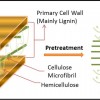 This 4-page fact sheet discusses bioethanol as a renewable form of energy, explaining the importance of using ligno-cellulosic biomass to produce biofuels. It describes the pretreatment step in producing biofuels and the need for more research into this step so that ligno-cellulosic biofuels can be produced cheaply and efficiently at a commercial scale. Written by Zhaohui Tong, Nusheng Cheng, and Pratap Pullammanappallil, and published by the UF Department of Agricultural and Biological Engineering, January 2013.
This 4-page fact sheet discusses bioethanol as a renewable form of energy, explaining the importance of using ligno-cellulosic biomass to produce biofuels. It describes the pretreatment step in producing biofuels and the need for more research into this step so that ligno-cellulosic biofuels can be produced cheaply and efficiently at a commercial scale. Written by Zhaohui Tong, Nusheng Cheng, and Pratap Pullammanappallil, and published by the UF Department of Agricultural and Biological Engineering, January 2013.
http://edis.ifas.ufl.edu/ae495